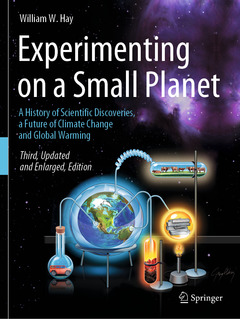Experimenting on a Small Planet (3rd Ed., 3rd ed. 2021) A History of Scientific Discoveries, a Future of Climate Change and Global Warming
Auteur : Hay William W.

This book is a thorough introduction to climate science and global change. The author is a geologist who has spent much of his life investigating the climate of Earth from a time when it was warm and dinosaurs roamed the land, to today's changing climate. Bill Hay takes you on a journey to understand how the climate system works. He explores how humans are unintentionally conducting a grand uncontrolled experiment which is leading to unanticipated changes. We follow the twisting path of seemingly unrelated discoveries in physics, chemistry, biology, geology, and even mathematics to learn how they led to our present knowledge of how our planet works. He explains why the weather is becoming increasingly chaotic as our planet warms at a rate far faster than at any time in its geologic past. He speculates on possible future outcomes, and suggests that nature itself may make some unexpected course corrections. Although the book is written for the layman with little knowledge of science or mathematics, it includes information from many diverse fields to provide even those actively working in the field of climatology with a broader view of this developing drama. Experimenting on a Small Planet is a must read for anyone having more than a casual interest in global warming and climate change - one of the most important and challenging issues of our time. This new edition includes actual data from climate science into 2021. Numerous Powerpoint slides can be downloaded to allow lecturers and teachers to more effectively use the book as a basis for climate change education.
William W. (Bill) Hay was born October 12, 1934, in Dallas, Texas. He received his B.S. in Biology from Southern Methodist University in 1955, M.S. in Geology from the University of Illinois at Urbana in 1958, and Ph.D. in Geology from Stanford University in 1960. As an undergraduate and graduate student he also studied at Ludwig-Maximillian's University in Munich under Wayne University's "Junior Year in Munich" program, and the University of Zurich as a Fellow of the Swiss Friends of the USA.
After a year of postdoctoral study at the University of Basel, Switzerland, he began his professional career at the University of Illinois in Urbana in 1960. In 1968 he become a joint Professor of Geology at the University of Illinois and Professor of Marine Geology and Geophysics at the Rosenstiel School of Marine and Atmospheric Sciences (RSMAS) of the University of Miami. He maintained this joint arrangement until 1974. From 1974-76 he served as Chairman of the Division of Marine Geology and Geophysics, and from 1976-1980 as Dean of RSMAS. From 1979 to 1982 he served as President of Joint Oceanographic Institutions, Inc. in Washington, D.C.
In 1982 he moved to Boulder, Colorado as Director of the University Museum, and was soon added to the faculty of Geology and CIRES. He resigned as Director of the Museum in 1987, and from 1990 to 1998 was on a half -time appointment at Colorado and half-time as Gastprofessor at GEOMAR, a marine geological research institute attached to Christian-Albrecht's-Universität, Kiel, Germany. In 1991-92 he was an Alexander von Humboldt Senior Research Scientist. In the summer of 1993 he was Gastprofessor in the Sektion Marine Geologie, Institute for Baltic Sea Research in Warnemünde, Germany, and in the fall of the same year F. C. Donders Professor at the Institute of Earth Sciences, University of Utrecht, The Netherlands. In the fall of 1995 and again in 2010 he was Gastprofessor, sponsored by the University of Vienna, in t
Explains the many aspects of climate science in easily accessible stories
New edition with up-to-date science
Powerpoint slides for each chapter provide perfect teaching basis
Date de parution : 09-2022
Ouvrage de 1001 p.
21x27.9 cm
Disponible chez l'éditeur (délai d'approvisionnement : 15 jours).
Prix indicatif 52,74 €
Ajouter au panierDate de parution : 09-2021
Ouvrage de 1001 p.
21x27.9 cm



